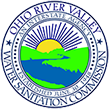Section 303(d) of the Clean Water Act requires states to develop Total Maximum Daily Loads (TMDLs) for waters not meeting designated uses after technology-based controls have been implemented. A TMDL establishes the allowable loadings of pollutants for a water body, quantifies the reductions necessary to meet all designated uses, and assigns load allocations to pollutant sources. The eight minimum regulatory requirements for TMDLs are as follows:
- TMDLs must be designed to meet applicable water quality standards.
-
TMDLs must include load allocations (LA) and wasteload allocations (WLA). A load allocation is an allowable pollutant load from non-point sources. A WLA is an allowable pollutant load from point sources. The combined LA and WLA must not result in violations of the applicable water quality standards.
-
TMDLs must consider the impacts of background (natural) pollutant contributions.
-
TMDLs must consider critical environmental conditions.
-
TMDLs must consider seasonal environmental variations.
-
TMDLs must include a margin of safety.
-
TMDLs must include public participation.
-
TMDLs must include reasonable assurance that the reduction goals set forth in the TMDL can be achieved and the applicable water quality standard can be met.
ORSANCO, through its Ohio River Watershed Pollutant Reduction Program, is assisting states and U.S. EPA (http://www.epa.gov/owow/tmdl) in the development of TMDLs for the Ohio River. A dioxin TMDL and the dioxin TMDL technical support document was completed in September 2000 for an 80-mile stretch of the Ohio River in West Virginia. This TMDL called for a 74 percent reduction of the daily dioxin load in the Ohio River. In September 2002, a PCB TMDL was completed for a 277-mile stretch of the Ohio River from East Liverpool, Ohio to Catlettsburg, KY. This TMDL indicates daily PCB loadings must be reduced by as much as 99 percent in order to meet the applicable ambient water quality standards.
The Commission’s TMDL efforts are now focused on the completion and public notice of the draft bacteria TMDL. Extensive monitoring conducted through the Ohio River Pollutant Reduction Program and the Contact Recreation Program has revealed slightly over half of the length of the Ohio River (64%, or about 682 miles) is impaired for primary contact recreational use. U.S. EPA is leading the effort to develop the TMDL through their contractor Tetra Tech. ORSANCO is providing the ambient water quality data necessary to complete the project, as well as serving along with the six Ohio River mainstem states on the Bacteria TMDL Work Group.
Other Programs
- Algae & Nutrient Monitoring
- Bacteria TMDL
- Biennial Water Quality Assessment
- Bimonthly Water Quality Sampling
- Clean Metals
- Contact Recreation Bacteria
- Dissolved Oxygen Monitoring
- Emergency Response
- Fish Population
- Fish Tissue
- Harmful Algal Blooms
- Macroinvertebrates
- Mercury Supplemental Studies
- National Rivers and Streams Assessment
- Nutrient Reduction Activities
- Ohio River Users
- Organics Detection System (ODS)
- PFAS Supplemental Study
- Pollution Control Standards
- Source Water Protection
- Water Quality Trends
- Watershed Pollutant Reduction
- Wet Weather Studies

